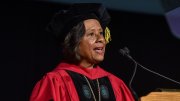In a populist presidential election year pervaded by economic discontents—lagging middle-class incomes, rising inequality, and the purported workforce displacements caused by immigrants, globalization, and free-trade agreements—the Radcliffe Institute addressed the issues head-on. Its morning symposium, “Building an Economy for Prosperity and Equality,” featured some of the most interesting researchers addressing these problems as participants in a searching, intelligent exchange of the sort that rarely occurred in the debates televised during the primary season. (Full participant backgrounds appear at the bottom of this post; the luncheon—which will be reported in full in a separate dispatch—featured remarks by Ben S. Bernanke ’75, former chair of the Board of Governors of the Federal Reserve System, followed by a conversation between Beren professor of economics Gregory Mankiw and Radcliffe Medalist Janet Yellen, the current Fed chair.)
At the panel’s end, just before noon, moderator Cecilia Rouse ’86, Ph.D. ’92 (a 2016 Graduate School of Arts and Sciences Centennial Medalist), asked each participant what platform she or he would advocate for a “Prosperity and Equality” third party. Their responses, drawing on their comments during the prior 75 minutes:
- Harvard Kennedy School dean Douglas W. Elmendorf advocated “government investment in things—and more importantly, in people.” Amplifying, he advocated “increasing our investment in young people, particularly lower- and middle-income people,” and paying for that investment by drawing resources from those who have done especially well during the past few decades.
- Lee professor of economics Claudia Goldin, an economic historian, said that given the disruptive effects of third parties, she did not advocate another one. Instead, “I want our current parties to think better”—perhaps arraying themselves slightly to the right and to the left of Elmendorf’s position.
- Louise Sheiner ’82, Ph.D. ’93, senior fellow in economic studies at the Brookings Institution, put a snappy twist on Elmendorf’s formulation, suggesting “investment in kids who want to make this country great again.”
- And David Autor, Ph.D. ’99, an MIT economics professor, pushed back against the “self-fulfilling prophecy” of under-funding public services and then deploring their poor quality, and advocated a plank that “embraces and esteems” public service. More technically, he advocated tax simplification, perhaps by capping tax expenditures—however individuals wished to take advantage of them (for charitable deductions, mortgage interest, and so on), at a low percentage of adjusted gross income.
A Vanished, Halcyon Era
Radcliffe Institute dean Lizabeth Cohen, an American historian, noted in her introductory overview of rising inequality and lagging growth that she had once written a book titled A Consumer’s Republic, about the halcyon, and now prehistoric-seeming, golden era in the post-World War II years, when the economy and incomes grew, and there was broad agreement that prosperity ought to (and would) benefit individuals and society alike. In those Cold War-era years, she said, economic equity was seen as democratic society’s best defense against communism. Against that backdrop, she continued, the challenge for the panel was to discuss what has happened since—more than three decades of rapidly rising inequality, and stagnation, at best, for politicians’ beloved “middle class”—and what do to about it.
The Panelists’ Prescriptions
In his opening statement, Autor said that inequality, to some degree, provides important incentives for growth in market economies. But excessive inequality, persisting over time, promotes “dynasticism,” undercutting the promise of democratic market societies. “If we make the race too unequal at the outset,” he said, “inequality becomes the enemy of opportunity.” He characterized the rapid growth and shared prosperity following World War II as, unfortunately, an anomaly: propelled by rapid gains in technology and workers’ education and skills, and by the United States’ finding itself in a position of economic leadership.
Now, he said, productivity growth has slowed, resulting in less economic wealth to share. Americans’ rate of higher-education attainment has also slowed, and for males, fallen. Moreover, the forces of technological change and globalization have combined to “amplify the value of scarce talents” (like running a multinational enterprise or creating software that can be used globally) but “commodify labor” for those with lesser skills (who earn a living by making shoes, sewing, and so on). That has been accompanied by a “certain” resignation” that this is the inevitable outcome of the market. The conclusion that nothing can be done is “simply incorrect,” he said; societies in Europe and Singapore have achieved lower inequality, higher social cohesion, and greater productivity growth by sharing gains. Autor concluded, “We have a lot of social and political choice” to exercise.
Sheiner, a health economist, said that debate over income inequality, which is subject to interpretation, had been joined by incontrovertible evidence over “inequality in life expectancy.” In the past, advances such as sanitation and public health were assumed to benefit the poor; it was also assumed that economic growth would narrow the age-old gap in life outcomes between the rich and the poor. But life-expectancy studies among different age cohorts have shown that in the United States, that gap is widening. Projecting from the 1960 cohort, she said, current trends would result in a life-expectancy gap of 13 years separating the top from the bottom income quintiles. Although causes and correlations are not fully clear, she said, policies aimed at addressing inequality directed toward lower-income children (better healthcare, better education) would certainly have positive outcomes for their longevity. The evidence, she said, is “a clarion call that we really need to do something about that.”
She also noted that the traditionally progressive social supports—Social Security and Medicare—are perhaps less progressive than believed, given the radically shorter life expectancies of lower-income beneficiaries. That insight ought to direct any changes contemplated for these benefit programs.
Goldin noted that her historian’s discipline gave her a power unusual among economists, with their fraught art of forecasting: she could indulge in “backcasting,” with a highly reliable set of outcomes. She noted that the U.S. decision, early in the twentieth century, to invest in universal high-school education—a measure ridiculed by Europeans, who focused on elite schooling—had paid enormous, immediate returns in workers’ incomes as they took on more skilled jobs. That set the stage for the postwar period, when “America grew together.” The GI Bill, she noted, took those college-ready veterans and moved them up the educational ladder; the equivalent British legislation provided for education only to age 15.
The current situation, after several decades of Americans growing apart, most resembled the late nineteenth century, Goldin said, when in response to the excesses of the robber barons, the country entered an era of populist and socialist third-party movements, and of rampant opposition to immigration. “Sound familiar?”
The high returns to high-school education then are echoed in the high returns to college education today, she said: there are “significant gains to most types of post-secondary education” for almost all potential students. Whether economic growth can be reignited is “the hardest part,” she concluded. “Equity may be easier.”
Elmendorf briskly outlined federal fiscal measures to “generate inclusive economic growth”:
“Increase investments in education and training.” Under the present budget caps, he said, U.S. spending on infrastructure, research and development, and education and training will soon fall to the smallest share of Gross Domestic Product in 50 years—the wrong way to prepare for the future, and disastrous for those at the bottom of the economic scale.
“Maintain benefits for middle- and lower-income people, rather than cutting them,” especially to invest in children whose future economic prospects will rise as a result of such investments. Transfer payments, he noted, lessen the effect of market forces that erode workers’ earnings, and buffer the devastating effects of recession on those less well-off, whose jobs and earnings are most vulnerable.
Keep demand for goods and services “high enough to cause full employment,” which draws workers into the labor force, and increases wages. That will be harder to do during future recessions, given the low interest rates now in place; but rushing to reduce federal deficits in 2010 was, he said, the biggest error in fiscal policy coming out of the recession.
With Janet Yellen (for whom he’s worked twice) seated in the front row, he urged the Federal Reserve Board to maintain monetary policy that would pursue both of its mandates: full employment and stable inflation.
Following the panelists’ presentations, Rouse, as moderator, asked them about trade (it is always controversial, Autor said, but its recent salience at least made people realize that, while the benefits are diffuse, the costs are concentrated on workers who are displaced—and that those “extremely disruptive” consequences had to be addressed); and making government expenditures effective (Goldin said for all the complaints about pork-barrel “bridges to nowhere,” the decreased spending on public and community colleges meant that in those sectors, “really important bridges have been taken down”).
The Audience Weighs In
Having been talked up to, the audience responded with lively, substantive questions, submitted on cards through the moderator.
On women and work, Goldin said that highly educated women are pursuing “positive assertive mating,” as Harvard graduates, for example, marry one another, privileging their children’s prospects, but having a multiplier effect on inequality.
What about the role of unions and the minimum wage? The panelists favored a broader set of labor-market institutions to buffer workers.
Were the panelists worried about deficits, if the government spent and invested more? Elmendorf said he surely was, in the long term. He advocated raising monies from those who have done better in society (cutting their Social Security benefits, raising Medicare premiums, for instance)—a suggestion greeted, to his amusement, by applause. He continued, “I don’t mean just Bill Gates,” and suggested extracting resources from the top third to half of the economic order—a suggestion, he joked, that elicited “slightly less applause.”
Further discussion focused on the threat of job losses to robots and automation (see Harvard Magazine’s “Who Owns the Robots Rules the World”). Autor said such concerns dated back 200 years. Today, though, when the market amplifies the returns to experts (computer-programming superstars) and commodifies the labor of Uber drivers, the latter are hardly “enjoying” their newfound work flexibility, with its attendant lack of benefits and security. In 1900, he said, 38 percent of workers were on farms—and could not envision a world of software and app stores. Economic progress has, in tandem, resulted in ingenious new products and jobs, and consumption to match: problems of abundance, not of scarcity. Goldin noted other ways in which modern Americans enjoy those gains—for instance, on average, by working far fewer hours than their forebears.
On immigration, Autor said, the theory of displacement was the same as for the economic theory of trade, but the evidence of actual worker displacement was far more ambiguous except at those low-skilled, commodified kinds of jobs that had already been discussed. High-skilled immigrants, he said, were an unalloyed boon: “The fountainhead of so much greatness that has occurred here.” Goldin, pointing to Japan—with low fertility, rising longevity, no immigration, and a “tanking” economy—gave a vivid counterexample. In an aging population, like that in the United States, an adult immigrant is a “godsend,” as if “you gave birth to an educated 24-year-old who could take care of you and was likable”—a pleasing prospect for many of the alumnae and friends attending.
The Panelists
The panel, moderated by Cecilia Rouse ’86, Ph.D. ’92, dean of the Woodrow Wilson School of Public and International Affairs at Princeton, a scholar of labor economics and the economics of education, assembled experts on worker training and employment prospects, trade, health spending, fiscal policy, and other factors underlying the current challenges.
David Autor, M.P.P. ’94, Ph.D. ’99, professor of economics at MIT, has written a series of exceptionally important, pertinent papers on the current challenges facing middle-class workers—an interest manifest in his Harvard Kennedy School doctoral thesis, which dealt with computerization, inequality, and the rise of the contingent workforce. His co-written 2014 paper, “Trade Adjustment: Worker Level Evidence,” documented that practice (lower-wage and manufacturing workers displaced by trade, especially from China’s rapid rise as an exporter of manufactured goods) does not follow the theory (that such workers would redeploy successfully to new jobs)—meaning that the benefits of inexpensive imports enjoyed by all consumers are paid for, in part, by the disproportionate income and employment impacts on displaced domestic production workers. A recent follow-up paper, titled “Importing Political Polarization? The Electoral Consequences of Rising Trade Exposure,” found “an ideological realignment that is centered in trade-exposed labor markets….” The study was prominently featured in The New York Times, under the headline, “Where Jobs Are Squeezed by Chinese Trade, Voters Seek Extremes.” (Note to the electorate about those Chinese manufactured goods: don’t blame a trade agreement—the United States doesn’t have one with the People’s Republic.)
Harvard Kennedy School dean Douglas W. Elmendorf, Ph.D. ’89, is newly arrived from directing the Congressional Budget Office—where he occupied one of the best seats from which to view the federal fisc (including policy decisions like those surrounding the country’s determination not to aid workers laid off by foreign trade very generously). A macroeconomist, he has had pertinent things to say about U.S. prospects. In a recent New York Times “Economic Scene” column, Eduardo Porter reported this pungent Elmendorf comment that might apply to politicians’ overblown campaign promises: even with the best intentions, “[W]e are not going to get back to three percent [growth] with anything we know how to do.”
Lee professor of economics Claudia Goldin, RI ’06, has written extensively on education, technology, and workers’ prospects (in particular, on Americans’ diminishing rate of growth in educational attainment, and the implications for remunerative work) and, more recently, on gender disparities in employment.
Louise Sheiner ’82, Ph.D. ’93, who was an economist at the Fed for more than two decades, is now senior fellow in economic studies and policy director of the Hutchins Center on Fiscal and Monetary Policy at the Brookings Institution. She has focused in particular on health spending and fiscal policy.









